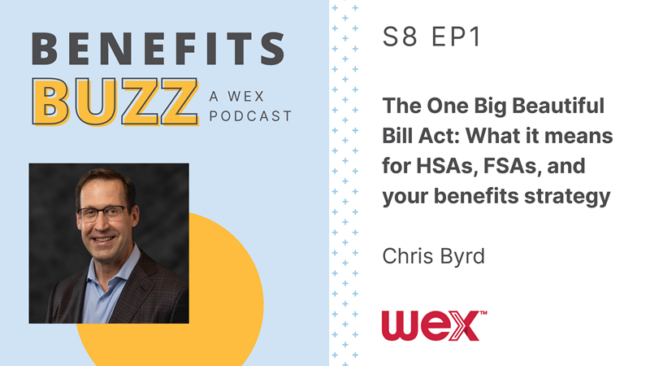Stay connected
Subscribe to our Inside WEX blog and follow us on social media for the insider view on everything WEX, from payments innovation to what it means to be a WEXer.

Congress passed and President Trump has signed into law the One Big Beautiful Bill Act – and it’s a game changer for health savings accounts (HSAs). In this episode, Chris Byrd, WEX Health & Benefits senior vice president, breaks down the most impactful provisions of the bill, including expanded health savings account (HSA) eligibility for ACA exchange plans, the inclusion of direct primary care and telemedicine, and also an increase in dependent care FSA contribution limits. We’ll explore what these changes mean for you and your employees—and what steps we recommend you take to prepare for 2026 and beyond. Check out our podcast episode with Chris Byrd below:
Chris Byrd highlighted three changes included in the One Big Beautiful Bill Act:
It’s not just HSAs seeing improvements. The bill also raised the annual contribution limit for dependent care flexible spending accounts from $5,000 to $7,500, effective for plan years starting January 1, 2026. Aside from a temporary increase in the American Rescue Plan Act of 2021, the limit was set by Congress in 1986 and has remained constant since then. The increase will benefit working families by lowering their cost of childcare, although the amounts are not indexed for inflation going forward.
Byrd recommends employers and benefits administrators should start preparing for these changes by:
While not every proposed benefit made it into the final version—like pre-taxing ACA exchange premiums or reinstating bicycle commuting benefits—Byrd expressed optimism that this bill is a significant step toward greater flexibility in HSA plan design. Looking forward, he shared that advocacy efforts will now focus on expanding HSA access for working seniors and extending HSA qualification for bronze and catastrophic plans to the group market—important changes that could further improve healthcare affordability and access for millions more Americans.
Don’t forget to watch our podcast episode with Chris Byrd for additional insights!
The information in this blog post is for educational purposes only. It is not legal, tax or investment advice. For legal, tax or investment advice, you should consult your own legal counsel, tax and investment advisers.
WEX receives compensation from some of the merchants identified in its blog posts. By linking to these products, WEX is not endorsing these products.
Subscribe to our Inside WEX blog and follow us on social media for the insider view on everything WEX, from payments innovation to what it means to be a WEXer.